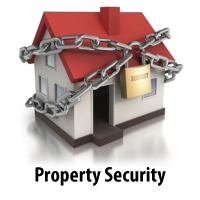 Property Security
Property Security
This page is intended to describe security and safety relating to property being readied to send to University Surplus and Salvage (US&S). This page is intended as a brief overview and does not include every aspect of security or safety.
Information Security
- Property should be double checked to make sure no documents are left behind in desks, file cabinets or other storage units. All locked cabinets or drawers should be unlocked. Sensitive data must be handled according to university regulations and department policies and it should not be sent to University Surplus and Salvage.
- Identify hard drives and other electronic data storage containing equipment and media. Besides computers, many devices have data storage capabilities such as high end copiers, cellular telephones, and some medical devices. Dispose of the data storage device according to approved procedures in your department. Surplus does destroy hard drives at no charge and sends e-waste to approved recyclers. Surplus follows G4-004N1 Media Sanitization and Destruction regulation and policy 3-041 Accountability for Noncapital Equipment. See III.B.5.
- Asset Identification Numbers, Descriptions, Makes, Models and Serial Numbers should be recorded on the transferring or retiring paperwork. The Retirement/Transfer Form (RT) is the university form to use for this purpose. It is available through the Property Accounting website.
Safety
- Do not block hallways or aisles with the property
- Do not put equipment in stairwells. This is against fire codes.
- Do not block entrances or exits with the property
- Do not block fire extinguishers with the property
- Lift with your legs and not your back. Don’t bend at the waist. Bend with your knees and keep your back straight.
- Use proper material handling equipment to move property
- Use gloves
E-Waste
- Monitors and electronic devices which contain circuit boards and equipment with batteries are considered electronic waste and cannot be thrown in to a trash bin. Send this equipment to US&S. If the item cannot be sold, US&S recycles e-waste through University approved recyclers.
Metal Recycling
- Do not put metal into trash bins. The University recycles metals.
Physical Security of Assets
- Keep property in a secure area
- Have someone at the location when US&S receives the property to explain any discrepancies between the paperwork and the equipment at the location.
- Turn in your surplus as soon as possible. Do not wait to gather enough property for a large truckload. Some surplus pieces lose value quickly, your space is valuable, and it is easier and faster for University Surplus & Salvage to remove the equipment.
Hazardous and Infectious Waste
Surplus will not accept hazardous and infectious waste. Hazardous waste is disposed through the Office of Environmental Health and Safety. Examples of hazardous waste are oils, chemicals, unknown substances, ignitable waste, corrosive waste, reactive waste, toxic materials, pesticides, sharps and paints. Examples of equipment with potential hazardous or infectious waste are coulter counters (mercury), thermometers (mercury), power supplies with oil transformers, pipes with asbestos insulation, ceiling tiles (need to be tested for asbestos), syringes, needles, glass vials and any garbage can with a bio hazard label. The bio hazard labels must be removed before US&S can take the garbage cans.
Refrigerated Units
Freon and the compressor must be removed from these units before they will be received by US&S. See refrigeration equipment and appliance disposal information at the Office of Environmental Health and Safety website. Examples of equipment with refrigeration compressors are window air conditioners, freezers, ultra-low freezers, refrigerated centrifuges, refrigerators and water fountains.
Radioactive Waste
Surplus will not accept equipment containing radioactive materials. These items are disposed by US&S after the source is removed by the Office of Environmental Health and Safety (EHS). Examples of equipment that must be cleared first by EHS are scintillation units and X-Ray machines.
Laboratory Equipment
Equipment needs to be cleaned before it is sent to US&S like, Biosafety cabinets, fume hoods and microtomes. Any Biohazard labels must be removed. Follow guidelines of the Office of Environmental Health and Safety Department.
